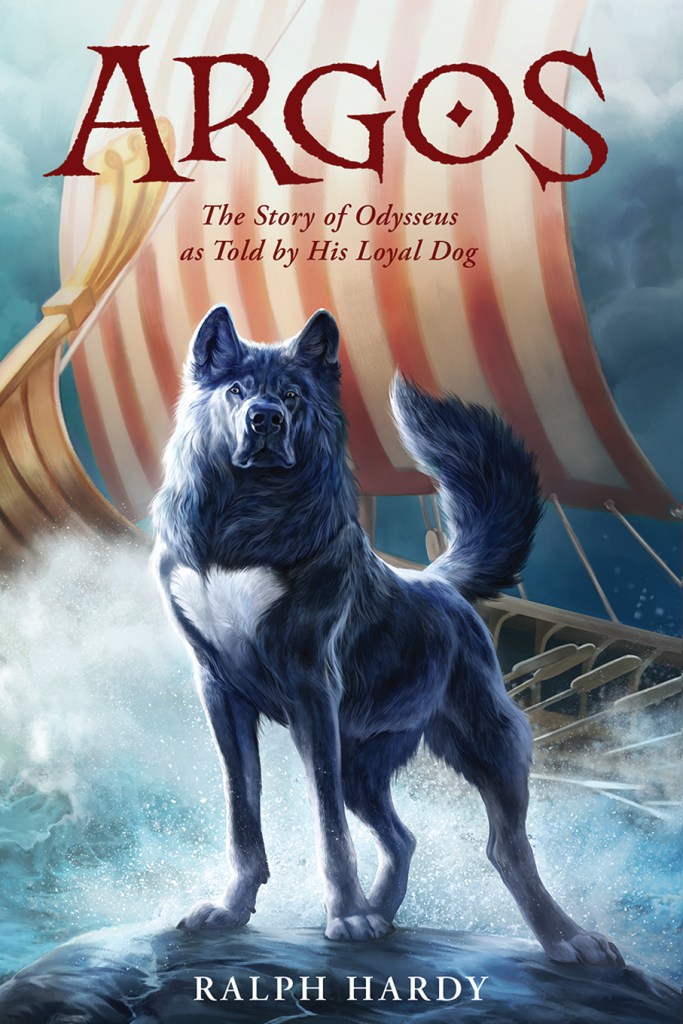Here’s a cool thing to do: go to author readings. Your public library or your local bookstore might have them, and they’re usually free. It’s heartening for the author, even if you don’t buy their book; it boosts the library’s attendance statistics, if it’s at a library; and you get to be read to like a kid and entertained. And, if you’re a writer who’s aiming at publication, you can snag yourself some interesting and useful information.
(Also, for writers scoping out these events, it’s fun to feel like you’re undercover. Taking notes is a lot cooler when you’re “gathering intel” than when you’re “attending math class”.)
Two days ago, I went to just such an author talk, and I learned all kinds of things! The author, Ralph Hardy, has written a novel that retells the story of The Odyssey from the perspective of Odysseus’ dog, Argos.
(FYI: I had never met this author, and have no connection to him, except that I think he’s a member of the same SCBWI chapter I am. This post isn’t some kind of sneaky advertising, just my observations.)
The audience was almost half kids under fourteen (at my estimate), which is the book’s target audience. (And, incidentally, will be the target audience for MY dog-centric middle-grade book, so I was especially interested to see how this reading would go.) Then there was the author, a person sitting at a table with copies of the book for sale, and a library staff member to help run the program.
First off, I took notes on how the reading was organized. Here they are, along with some conclusions I drew:
- It started at 4:00 p.m. on a Tuesday. If your target audience is mostly kids, make sure they’ll be out of school when you do your reading!
- The author started by introducing himself and his book. He quizzed the kids about Greek mythology (they were GOOD, presumably courtesy of Rick Riordan). He then gave a quick, lively summary of the Trojan War. Know your audience, and know how much background to give them about the book.
- Next up, Mr. Hardy briefly introduced, then read, two short chapters (the first one and a later one). His introduction included general setup facts for the novel, such as “All the animals can talk to each other, but not to humans.” When reading, he would pause to engage the kids in the audience (“Who knows what a ‘stag’ is?”). Consider not reading for too long. Pick short sections with dramatic endings.
- He showed us a blown-up version of the cover and talked about getting an international call from the illustrator, who asked, “What does the dog look like?” His answer: “Big, and black, and wolfish, with a white shield on his chest.” He was enthusiastic about the cover. (I would be, too!) Visuals are great. So is enthusiasm!
- He mentioned that the book can potentially tie in with The Odyssey, which kids in North Carolina are required to read in ninth grade. Again, know your target audience.
- All of this had taken about twenty minutes. He spent the rest of the event – maybe another twenty-five minutes – doing Q&A.
The kids were engaged and interested, if slightly squirmy, which is to be expected for kids that age who just got out of school. But they were very keen on the Q&A. This afforded me another useful learning opportunity: what are some of the questions that middle-school-aged kids might ask an author?
Well, here are the questions they asked. (Unless otherwise noted, these were all asked by kids.)
- How long did it take you to write it?
- Why did you want to write the book?
- Was Argos really a dog in The Odyssey?
- Are you going to make a sequel?
- What is your writing schedule like? (Asked by an adult – not me!)
- What are your other books [that he had mentioned] about? (Also asked by an adult.)
- What was your favorite book as a kid?
- Do you prefer Greek or Roman mythology?
- Have you ever made a comic? (He had mentioned in response to Question 7, that he loved comics.)
- [Clarification question about one of the other books he had mentioned]
- Do you have any desire to write for adults? (Asked by an adult.)
- Have you written books under any other name?
1, 2, 4, and 7 are variations on questions that I’ve heard authors say they get asked all the time. But it was neat to hear some of the author-specific questions, like 3 and 8.
The audience seemed quite interested in concrete details about publishing. Then again, Mr. Hardy had some pretty interesting ones to share (“There were three rounds of edits. The last one was one sentence: ‘Put it in present tense.'”). They also liked fun personal stories, like how the author did a reading at his hometown library, and his ninety-five-year-old kindergarten teacher attended.
A couple of things that interested me perhaps more than the non-writers in the audience:
- The book is 83,000 words. It’s always been acceptable for fantasy to go longer than other genres, but I still feel like the accepted length for MG has gone up in recent years. Thanks, J.K. Rowling!
- He writes every weekday morning, aiming for between 500 and 1500 words per day.
- He regrets publishing an earlier book under the name R.K. Hardy. He did it because people advised him that it was wise to obscure your gender to avoid alienating certain readers. Now, though, he sees it as a mistake because people who search his name don’t find all of his books.
See? Just a few of the fascinating things you can learn at an author talk. If you’ve been to any good ones, I’d love to hear about it!
